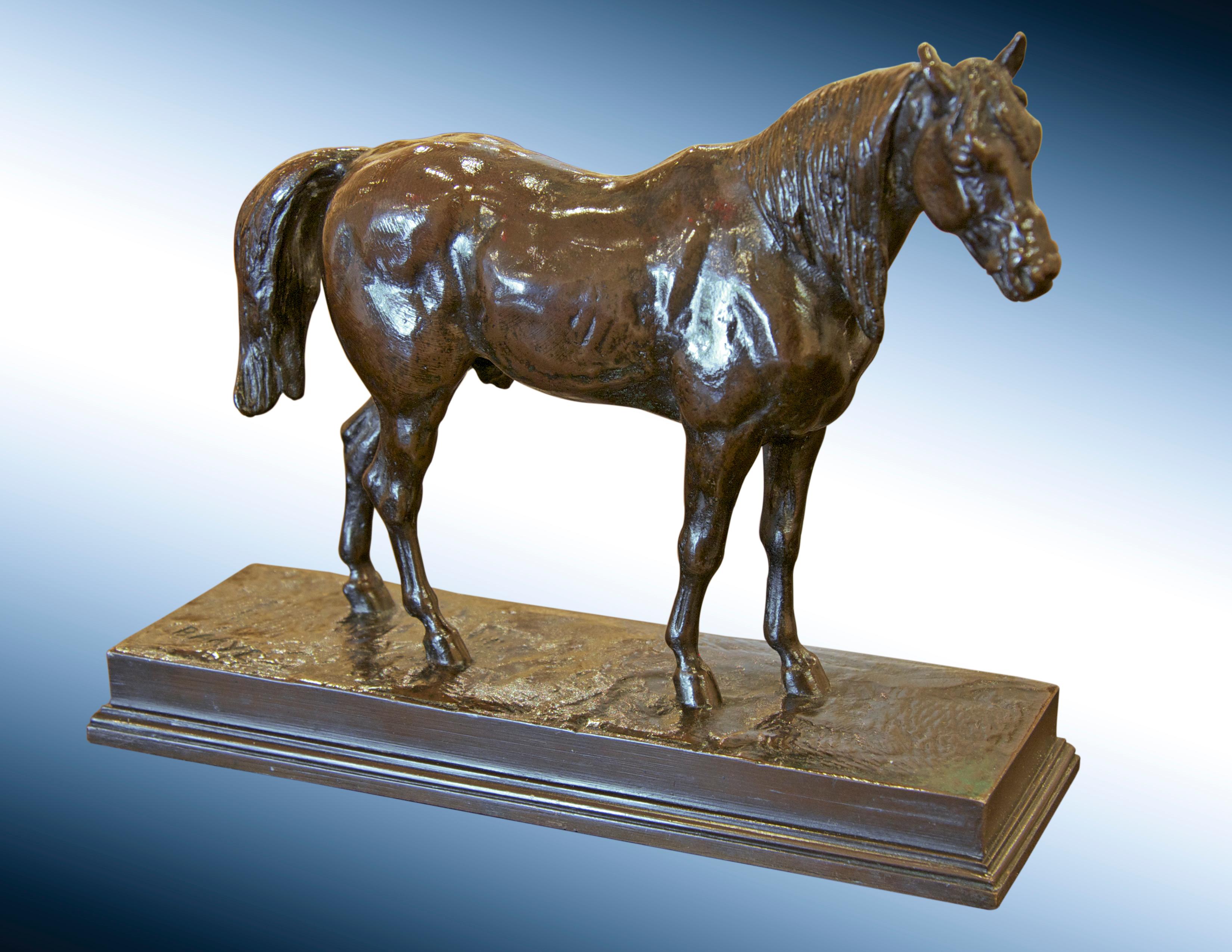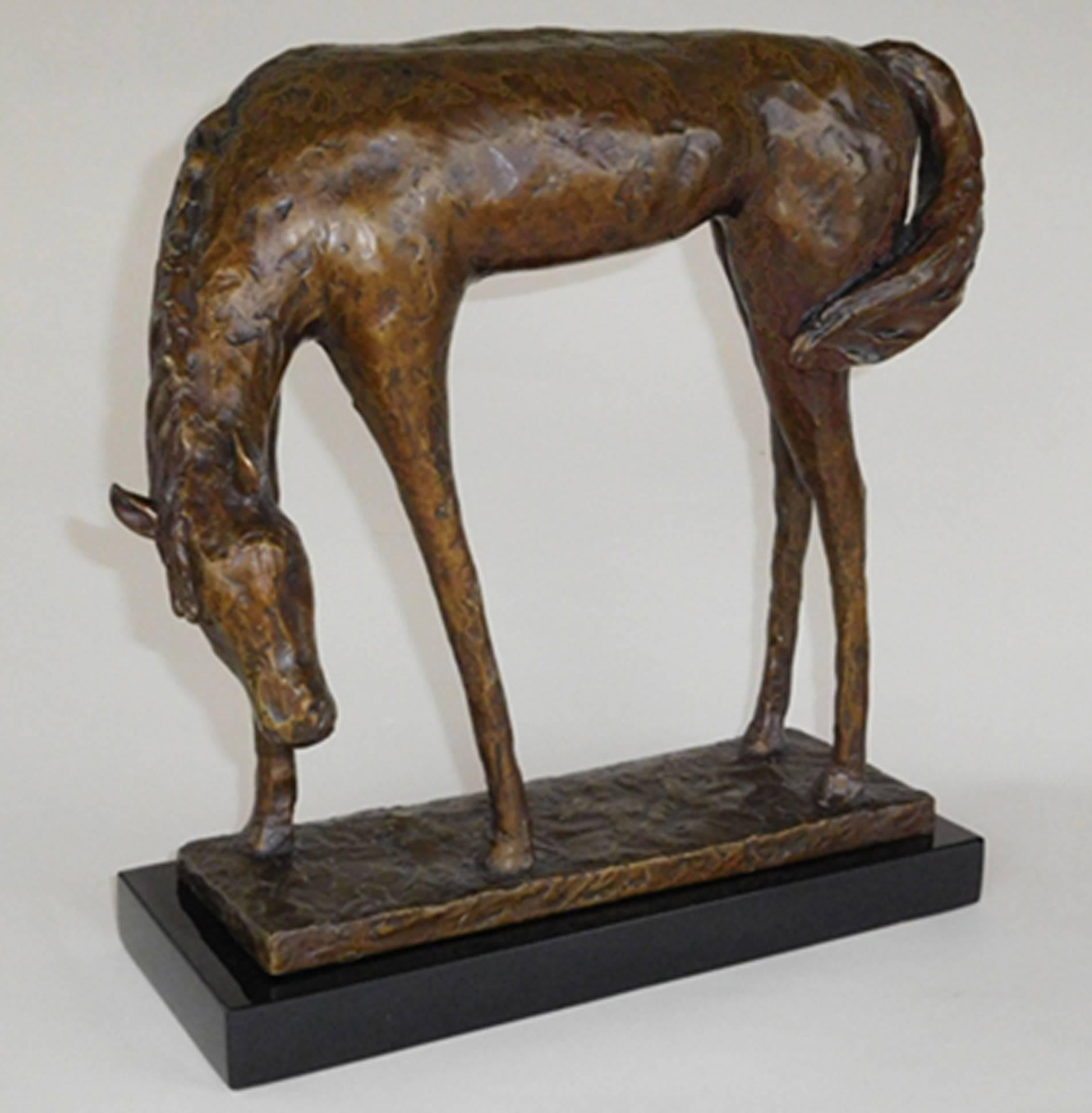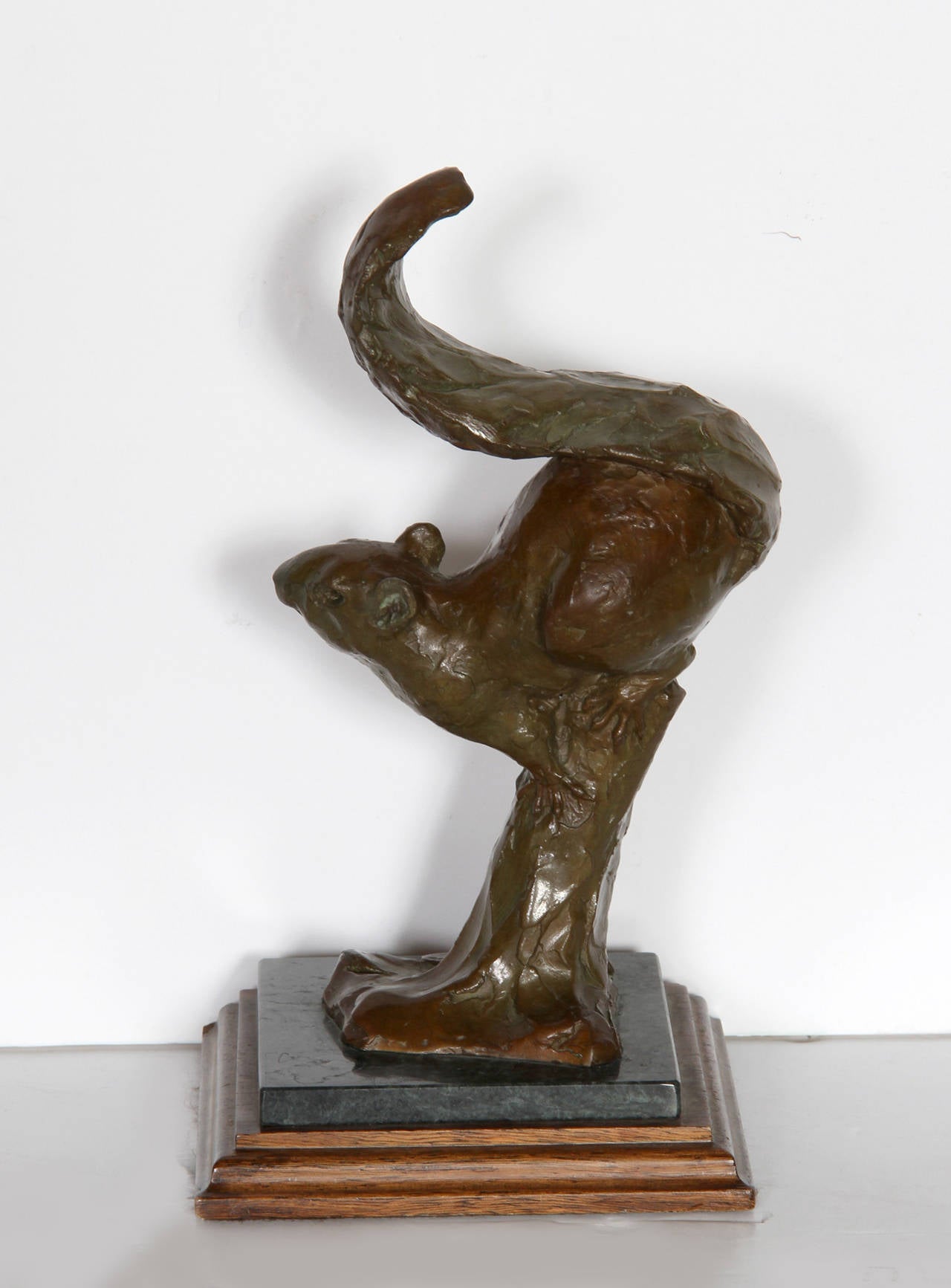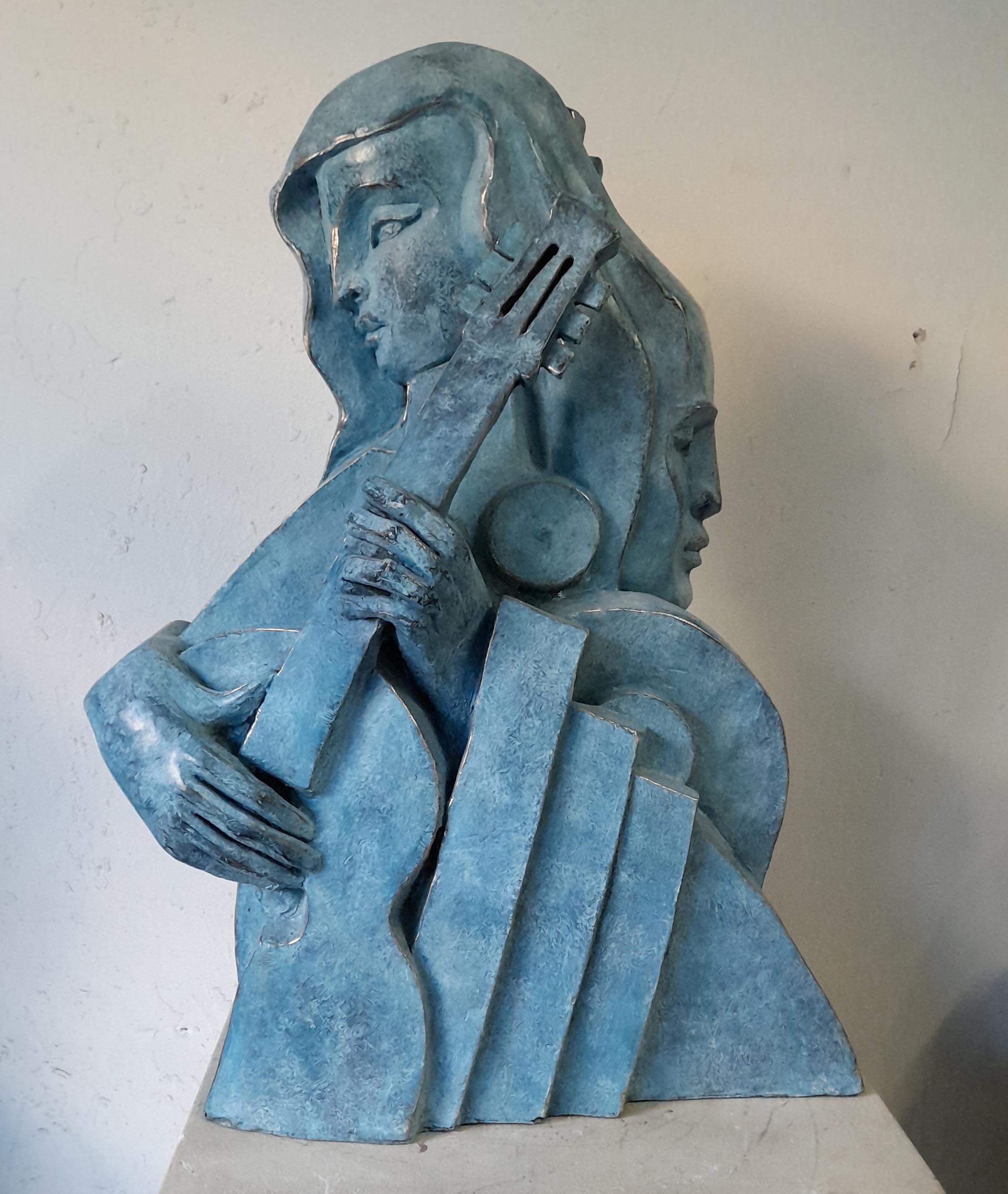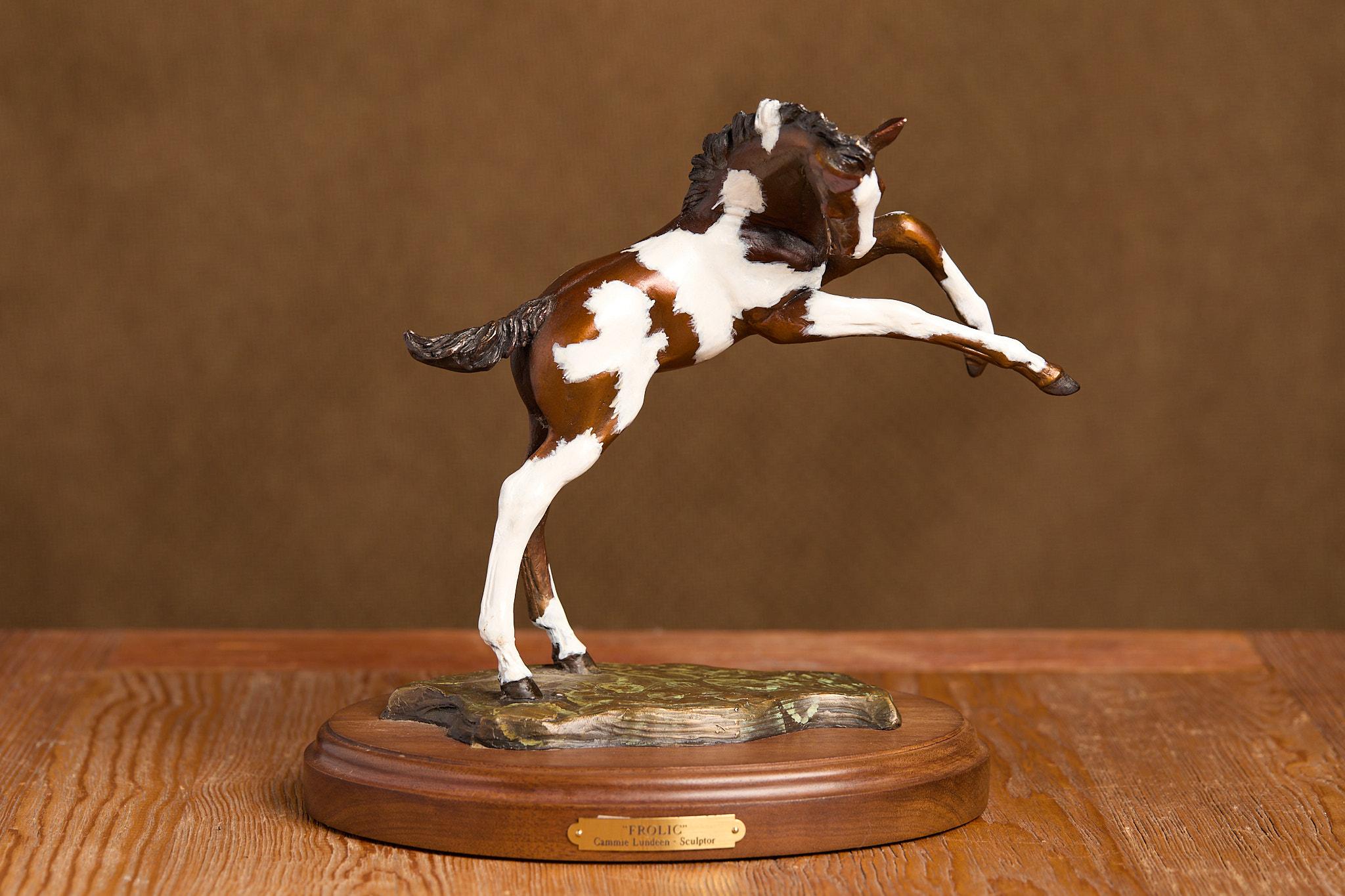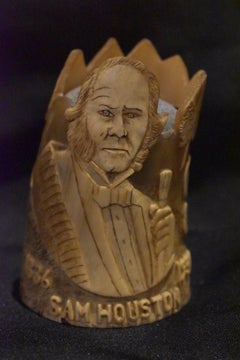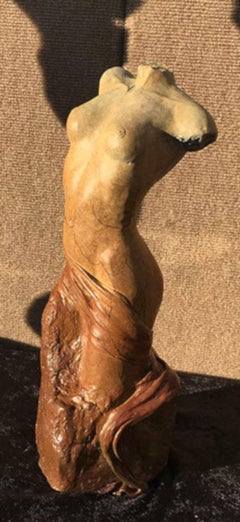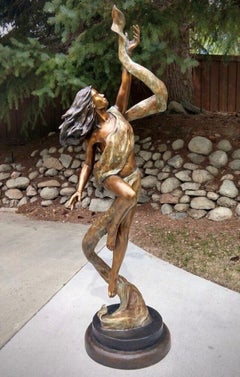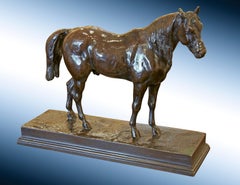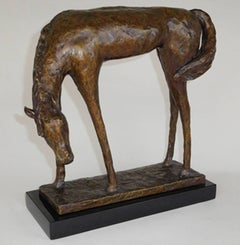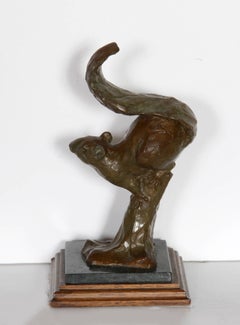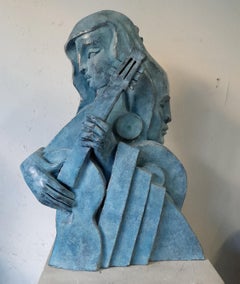Items Similar to " THE LAST DROP " Charles Schreyvogel (1861-1912) BRONZE SCULPTURE 1903 WESTERN
Want more images or videos?
Request additional images or videos from the seller
1 of 10
Charles Schreyvogel" THE LAST DROP " Charles Schreyvogel (1861-1912) BRONZE SCULPTURE 1903 WESTERN1903
1903
About the Item
Charles Schreyvogel
(1861-1912)
New York / New Jersey Artist
Image Size: 12" x 18.50" x 5"
Medium: Bronze Sculpture
1903
"The Last Drop"
Charles Schreyvogel (1861-1912) New York / New Jersey Artist
One of the better-known painters of Western subject matter, Charles Schreyvogel was especially interested in military life in the days of the disappearing frontier. His western scenes were usually subjects with landscape as the backdrop, and his depictions of Indians were that of people with dignity and pride. "His favorite theme was warfare between intruding whites and Indians defending their ancestral homelands." (Baigell, 321)
He spent most of his life as an impoverished artist and then earned what seemed like overnight fame. "When Remington died in 1909, Schreyvogel wore the mantle of premier Western artist for the brief remainder of his life." (Zellman, 557)
Schreyvogel was born in New York City and grew up in a poor family of German immigrant shopkeepers on the Lower East Side and also spent much of his childhood in Hoboken, New Jersey. He found work in art-related trades including as a Meerschaum pipe carver, goldsmith, and lithographer.
He taught himself to draw, but he studied with H. August Schwabe at the Newark Art League. By 1880, he was teaching drawing and painting and used the roof of his apartment in Hoboken as his studio. In 1887, with the help of several patrons, especially Dr. William Redwood Fisher, he went to Munich, Germany for three years and studied with Carl Von Marr and Frank Kirchbach. Dr. Fisher encouraged the artist to take an interest in western subject matter.
Returning to the United States, he had bad health and was advised to go West to regain strength, but he didn't have the money for several years so he satisfied his aroused interest by sketching cowboys and Indians he saw in Buffalo Bill's Wild West Show.
In 1893, Schreyvogel first went West, visiting Arizona and the Ute Reservation in southwest Colorado. He quickly regained his health and excelled as a horseman. He also learned sign language to communicate with the Indians to persuade them to pose for him. But the resulting paintings didn't sell in the East, so he, having married Louise Walther, earned money with portrait painting of miniatures on ivory while continuing to do western painting.
In the 1890s and 1900s, he made additional trips West, including the Blackfeet Reservation in Montana. In 1901, his work, My Bunkie, won the first-place honor, the Thomas B. Clarke Prize, at the National Academy of Design, and a market for his western paintings and sculpture was set. My Bunkie was a rejected painting that even his local cafe owner had refused to hang, and despairing, he had left it at the Academy. He was so sure he would get no recognition that he had not even bothered to leave his address.
He worked from studios in Hoboken, New Jersey, and from a farm in West Kill, New York, and his Academy success was followed by winning a bronze medal in Paris and another at the Pan-American Exposition in Buffalo.
The money he earned from this recognition allowed him to do more traveling in the West where he gathered material for his studio painting, many of them military scenes. Most of his canvases were large, but he was such a meticulous painter that he only completed about seventy-five western paintings. He also did some watercolors, and many of his paintings were reproduced during his lifetime.
He died in Hoboken from blood poisoning from a chicken bone lodged in his gum. His studio and collection are on permanent display at the Cowboy Hall of Fame in Oklahoma City.
Sources:
Peter Hastings Falk, Editor, Who Was Who in American Art
Matthew Baigell, Dictionary of American Artists
Michael David Zellman, 300 Years of American Art
CHARLES SCHREYVOGEL (1861-1912)
Literature:
J.D. Horan, The Life and Art of Charles Schreyvogel, New York, 1969, page 55.
Charles Schreyvogel was born in New York City in 1861 the son of migrant Germans bound and determined to make America their new home following departure from a tumultuous Europe and, specifically, Germany. His father, Paul, and mother Teresa Erbe Schreyvogel were shopkeepers in New York's lower east side. Charles was the second of three sons born in the family and from his early years in the public schools he surprised his teachers with delightful sketches.
These were the predecessors to his fervent desire to become an artist, an avocation that his prosperous, merchant father found little favor with. He was not to denied and early exposure to August Schwabe, a dedicated fan of the arts and struggling artists, and later to Dr. William Redwood Fisher, led to study in Europe at the Munich Art Academy with Karl von Marr and Frank Kirchback.
Charles Schreyvogel eventually became one of the most popular artists ever to depict the American West in paint and bronze. His early life of struggle with poverty and health led to an ever-present desire to excel. His first national recognition came from a first prize in the 1900 National Academy Exhibition with his entry, My Bunkie. Numerous works were reproduced as lithographs, gravures and platinum prints. The Duel is one such work to have been reproduced.
His extensive forays to the west resulted in field sketches that were used in his Hoboken, New Jersey studio to depict some of the most popular renditions of American cavalry officers and their Indian adversaries. His highly publicized debate with the very popular, and jealous, artist, Frederic Remington, over the authenticity of the ingredients and the scene depicted in his painting, Custer's Demand resulted in an outpouring of support from relatives and friends of Custer: his widow, Elizabeth, President Theodore Roosevelt and Col. J. S. Crosby, himself depicted in the work. His place in history was firmly established by his expertise and talent.
His works are scarce and sought after. Fewer than one hundred paintings are known to have been recorded due to his limited output and short life span. His works are held sparingly by major museums and collections worldwide.
Charles Schreyvogel was born in New York City in 1861 and died in Hoboken, New Jersey in 1912. A poor boy on the east side of New York City, Schreyvogel sold newspapers and worked as an office boy while being educated in the public schools. When his parents moved to Hoboken, he carved Meerschaum and was apprenticed to a gold engraver, then became a die sinker, and finally, in 1877, a lithographer.
By 1880, he was a lithographic artist and teaching drawing. By 1887, he had patrons enabling him to study in Munich for three years, the pupil of Carl Marr and Frank Kirchbach. When he returned, he existed as a lithographic artist while unsuccessful with portraits, landscapes, and miniatures on ivory. After sketching the Buffalo Bill Show personnel in New York, he was able to spend 1893 in the West.
For five months, he sketched in Colorado at the Ute Reservation, then went to Arizona to sketch the cowboys. When he came back to Hoboken with a collection of gear, he continued as a lithographic artist while his paintings of Western Army life did not sell. One of these paintings was My Bunkie, which he could not dispose of either as a painting or for lithography in 1899. Offered to a restaurant on consignment, it was hung in a dark corner, so Schreyvogel took it back and entered it in the 1900 National Academy exhibition without leaving his address. When My Bunkie won the highest prize of $300.00, no one at the Academy had until then heard of Schreyvogel or knew where he lived.
Immediately successful, Schreyvogel went West again in 1900, sketching troopers and Indians in the Dakotas for the series of paintings on the Western Army. In 1903, Remington who was the most important Western illustrator called Schreyvogel's work "half-baked stuff", but the soldiers depicted spoke up for him. His output was limited to relatively few major works per year because of the number of his research trips and the size of the paintings, but reproductions were widely published. One set of these was in the form of "platinum prints," that is, large photographs.
When he died in 1912 from blood poisoning after a chicken bone stuck in his gum, he left relatively few Western oils. There were also left clay models that were later cast into bronze.
Charles Schreyvogel was Frederic Remington's chief rival during the early years of this century, when interest in artistic depiction of the West was very high. Unlike Remington, Schreyvogel never worked as an illustrator, seeking instead to establish his reputation as an academic artist.
He was born in New York City and in 1886 went to Germany to study at the Munich Academy. Returning to America, he set up a studio in Hoboken, New Jersey, which was then a rural town surrounded by fields and marshlands. Almost immediately he became friends with Nate Salisbury, Buffalo Bill Cody's energetic manager for the Wild West Show, and Schreyvogel spent many hours sketching the Indians and cowboys whom he saw there.
In 1893 Schreyvogel journeyed to the Ute reservation at Ignacio, in the southwestern corner of Colorado. There he observed the Apache, Navajo, Utes, and other tribes who came to receive their government allotments, and he listened to their stories of the Plains Indian wars. He collected great quantities of artifacts, including full costumes and uniforms, which he later utilized in paintings. Returning to Hoboken, Schreyvogel decorated his studio with memorabilia and photographs, and set to work methodically depicting the events of the Indian wars at the close of the frontier period.
The artist researched his subjects painstakingly through various methods of clay modeling and employing live models, prior to transferring their likenesses onto canvas. This enabled Schreyvogel's details to be carefully delineated and subordinated to the whole, which lent itself to telling the story in a complete and cohesive manner. "He is more than a historian of the Indian," one writer observed during the artist's lifetime. "He is giving us an invaluable record of those perilous days of the western frontier when a handful of brave men blazed the path for civilization and extended the boundaries of empire for a growing nation." These words were written after the death of Remington in 1909, when Schreyvogel was proclaimed "the greatest living interpreter of the Old West."
ReSources include: The American West: Legendary Artists of the Frontier, Dr. Rick Stewart, Hawthorne Publishing Company, 1986
Charles Schreyvogel worked as an apprentice to a gold engraver as a young boy and later became a die sinker. In 1877 he tried to earn income as a lithographer, but his lifestyle remained quite meager. He attended the Newark Art League and studied with August Schwabe and then went to the Royal Academy in Munich from 1887-90. He enjoyed painting Western scenes and was able to travel West due to the patronage of W.R. Fischer. While on his trip, Schreyvogel sketched in Colorado and Arizona. He made a second trip west in the same year to sketch troopers and Indians in the Dakotas for a series on the Western Army.
His work did not sell until he entered a painting from his travels, "My Bunkie", into the National Academy of Design exhibition in 1900. He won first prize and gained sudden success at the age of 40. "My Bunkie" is a dramatic Western scene of a cavalryman rescuing an unhorsed comrade from pursuing Indians. Schreyvogel was favorably compared with Frederic Remington, another Western genre painter. "Custer's Demand" (1903) received critical acclaim for its composition, drama and sense of color. Numerous works were reproduced and garnered a large following.
Schreyvogel died in 1912 of blood poisoning and left fewer that 100 known paintings.
- Creator:Charles Schreyvogel (1861 - 1912, American)
- Creation Year:1903
- Dimensions:Height: 12 in (30.48 cm)Width: 18.5 in (46.99 cm)Depth: 5 in (12.7 cm)
- Medium:
- Movement & Style:
- Period:
- Condition:Please view my other items. We have a large amount of Vintage Texas & American Paintings, Landscapes, Westerns, Mid Century. Also a large selection of Vintage Bohlin Parade Saddles.
- Gallery Location:San Antonio, TX
- Reference Number:1stDibs: LU769315482802
About the Seller
5.0
Vetted Professional Seller
Every seller passes strict standards for authenticity and reliability
Established in 1974
1stDibs seller since 2017
93 sales on 1stDibs
Typical response time: 2 hours
- ShippingRetrieving quote...Shipping from: Fredericksburg, TX
- Return Policy
Authenticity Guarantee
In the unlikely event there’s an issue with an item’s authenticity, contact us within 1 year for a full refund. DetailsMoney-Back Guarantee
If your item is not as described, is damaged in transit, or does not arrive, contact us within 7 days for a full refund. Details24-Hour Cancellation
You have a 24-hour grace period in which to reconsider your purchase, with no questions asked.Vetted Professional Sellers
Our world-class sellers must adhere to strict standards for service and quality, maintaining the integrity of our listings.Price-Match Guarantee
If you find that a seller listed the same item for a lower price elsewhere, we’ll match it.Trusted Global Delivery
Our best-in-class carrier network provides specialized shipping options worldwide, including custom delivery.More From This Seller
View AllEDWARD BOHLIN 1940s 1950s SILVER MOUNTED PARADE SADDLE HOLLYWOOD WESTERN ARTIST
By Edward H. Bohlin
Located in San Antonio, TX
Edward Bohlin silver mounted parade saddle. Black Leather. Great Bohlin Stamp. Cowboy Saddle, Western Saddle. 1940s 50s one of his most desirable periods. Bohlin of Hollywood California. He made all of the saddles and other related western gear for the movies but mostly to ride in the "Tournament of Roses Parade" Rosebowl in California. The Corona was custom made using the original Corona as the sample to copy. Here is a little provenance on this saddle:
This is a rare saddle. We think there were only five made. They were marketed to Texas Buyers when in reality there wasn't a big market in Texas. The majority of these works of art were mostly purchased by California buyers.
This saddle was formerly owned by L.D. Brinkman. After his death it was acquired by a friend of mine. I purchased it from him Jan. 1, 2024, and sold it to one of my good friends and customer Jan. 3, 2024. Sadly, he recently passed away and the saddle is on the market again.
This Saddle is depicted in the Bohlin Catalog "The Lone Star Saddle"
Lloyd Donald Brinkman (1929 – July 4, 2015) was an American businessman, cattle breeder, civic leader and art collector. He was the owner of "the largest floor covering distributor in the US," and 350 pizza parlors with Gatti's Pizza. He bred Brangus cattle, and he was a significant collector of Western art.
Brinkman was born in 1929 in near Dagmar in Sheridan County, Montana. His grandparents were Danish immigrants who became homesteaders in the county.
Brinkman graduated from Pascagoula High School in Pascagoula, Mississippi. He attended Pearl River Community College, and he graduated from the University of Southern Mississippi, where he earned a bachelor's degree in marketing in 1952.
Brinkman initially worked in the flooring industry, even starting his own business in Dallas, Texas in 1960. It eventually became "the largest floor covering distributor in the US." Brinkman was also the owner of Gatti's Pizza, which operated 350 restaurants by the time he sold the business for $24 million in 2004.
Brinkman was also a breeder of Brangus cattle.
Brinkman was a co-founder of the Museum of Western Art in Kerrville. He served on the board of directors of the National Cowboy & Western Heritage Museum. He also served as the chairman of the public utility board of Kerrville, Texas. He was honored as the "Citizen of the Year" by the Kerrville Area Chamber of Commerce in 1984.
Brinkman was a collector of Western art. He owned paintings by American artists like Joe Beeler, E. Irving Couse, Frank Tenney Johnson, Gerald Harvey Jones, Robert Lougheed, Howard Terpning, and Olaf Wieghorst.
Brinkman was married seven times. He had a son, L.D. "Don" Brinkman Jr., and a daughter, Pamela Brinkman Stone.
Brinkman died on July 4, 2015.
Biography of Edward Bohlin
Edward Bohlin (1895-1980)
Edward H Bohlin Company (Established 1920)
Saddlery-Saddle Maker
1895-1980
Born in Sweden
Hollywood, CA.
Born in Sweden in 1895, Edward Bohlin ran away from home at age 15, working his way to America on a huge four-mast schooner with dreams of Buffalo Bill Cody's Wild West in his head. Ed worked cattle drives around Montana before opening his first saddle shop in Cody, Wyoming where he did rope tricks in front of his shop to draw business. He met Tom Mix while performing at the Pantages Theatre in Hollywood and Mix convinced Ed to stay and produce silver and leather items in the Los Angeles area. From his humble beginnings to his fame in Hollywood for high-end pieces, Ed crafted more than 12,000 Bohlin saddles...
Category
1940s Realist More Art
Materials
Silver
"SAM HOUSTON" HORN CARVING 1936 TEXAS CENTENNIAL AMAZING WORK
Located in San Antonio, TX
Dan Super "SAM HOUSTON"
(1873-1953)
Houston Artist
Image Size: 3 3/4 inches tall
Medium: Carved Horn of Sam Houston to celebrate the Texas Centennial.
Texas Centennial 1936
"Sam Houston Pin Cushion Holder"
Biography
Dan Super (1873-1953)
Dan E. Super, Jr. (1873 – 1953) Dan Super had the eye of a sculptor, envisioning and then creating hundreds of objects from the elongated form of a Texas Longhorn’s tusk. At the age of six, Dan Super carved his first drawing into a piece of the horn of a Texas Longhorn. Over the next 56 years, he made utilitarian pieces like pencil cups, pin cushions, and backscratchers, realistic replicas of animals and birds, and imaginative carvings of elegant nudes. While these carvings resemble the traditional art of scrimshaw, carvings from whale bone, we’ve not been able to identify another carver who used the Texas Longhorn as his material. “My work is done with an ordinary pocketknife, hacksaw file and rasp,” Super wrote in 1937. He used the horn in every way conceivable; whole, allowing the shape to define the object he was making, flattened to make mosaic or inlay work. He incised and pierced it and carved in the round. His own hands polished the horn to a sheen. Daniel Super, Jr. was born in Houston on August 22, 1873. His father owned stock years, D. Super and Brothers Co., providing the young Super with ready access to his raw material. Throughout his life, he worked in the businesses key to the identity and success of young, booming Houston, cattle, oil, real estate and rail. In 1896 he married Lula, and took over the family business, expanding it to include a grocery. He closed the company in 1912 and got into the oil business...
Category
1930s Realist Figurative Sculptures
Materials
Other Medium
"ANTICA" FEMALE FORM NUDE
By Scy
Located in San Antonio, TX
Scy
Colorado / Texas Artist
Image Size: 12"
Medium: Bronze
"Antica"
Scy has been surrounded by fine art throughout her entire life. She grew up beside the easel and sculpting stand...
Category
2010s Impressionist Figurative Sculptures
Materials
Bronze
"ZENITH" 5 FEET TALL BEAUTIFUL DRAPED NUDE REACHING FOR THE HEAVENS. A/P
By Scy
Located in San Antonio, TX
Scy
Texas Artist
Size: 5 feet tall.
Medium: Bronze Artist Proof / 44
"Zenith"
Scy has been surrounded by fine art throughout her entire life. She grew up beside the easel and sculpting stand...
Category
2010s Impressionist Figurative Sculptures
Materials
Bronze
"LA DOLCE VITA" WOMAN WITH WINE
Located in San Antonio, TX
Scy
Colorado / Texas Artist
Image Size: 13 inches tall
"La Dolce Vita"
Scy has been surrounded by fine art throughout her entire life. She grew up beside the easel and sculpting stand...
Category
2010s Impressionist Figurative Sculptures
Materials
Bronze
"SALUTE" WOMEM TOASTING WINE. FROM HER WOMEN OF THE VINEYARD SERIES BRONZE
By Scy
Located in San Antonio, TX
Scy
Colorado / Texas Artist
Image Size: 9" Tall
Medium: Bronze
"Salute"
Scy has been surrounded by fine art throughout her entire life. She grew up beside the easel and sculpting stand...
Category
2010s Impressionist Figurative Sculptures
Materials
Bronze
You May Also Like
Le cheval demi-sang arabe
By Antoine-Louis Barye
Located in Mc Lean, VA
A nineteenth-century cast of Antoine-Louis Barye's Le cheval demi-sang arabe (no. A125-Poletti; A148-Pivar), with nice patina.
Poletti and Richarme, Barye: ...
Category
Late 19th Century Realist Figurative Sculptures
Materials
Bronze
PAULA BLACKMAN Horse Bronze Sculpture small edition 2017 Female Artist Sculptor
By Paula Blackman
Located in Rancho Santa Fe, CA
A limited edition bronze Horse on a black marble base.
From the limited edition of 8.
Signed 1/8
Paula Blackman has been a bronze sculptor for 30 years working in Cleveland Ohio. ...
Category
2010s Realist Figurative Sculptures
Materials
Bronze
Squirrel I, Bronze Sculpture by T. Galbreath
By T. Galbreath
Located in Long Island City, NY
Artist: T. Galbreath
Title: Squirrel I
Year: 1997
Medium: Bronze Sculpture, Signature and number inscribed
Edition: 71/100
Size: 7 in. x 3 in. x 3 in. (17.78 cm x 7.62 cm x 7.62 cm)
Category
1990s Realist Figurative Sculptures
Materials
Bronze
Femme à la Guitare
By Mariko
Located in Miami, FL
The ultimate ride of the Christians Samurais riding their rhinoceroses.
Historical work by the sculptor Mariko about the troubled period of the 17th. Century where the Christians wer...
Category
21st Century and Contemporary Realist Sculptures
Materials
Bronze
Price Upon Request
Battle of the Market
Located in Wimberley, TX
Cammie Lundeen’s Battle of the Market is a commanding bronze sculpture that captures the iconic clash between bull and bear—universal symbols of financial markets. Set on a sweeping ...
Category
2010s Realist Figurative Sculptures
Materials
Bronze
Frolic, Mini
Located in Wimberley, TX
Cammie Lundeen’s “Frolic, Mini” is a joyful bronze sculpture capturing the exuberance of a young foal mid-leap. Standing just 8 inches tall, this finely crafted piece bursts with ene...
Category
2010s Realist Figurative Sculptures
Materials
Bronze
Recently Viewed
View AllMore Ways To Browse
Antique European Sculpture
Large Entry Sculpture
Antique Bronze Sculpture Signed Art Sculptures
Antique Bronze Sculpture Artists
Money Sculpture
Charles Page
Antique Western Signs
Antique Cowboy
Chief Sculpture
The Boy Bronze Sculpture
90s Bronze
Reproduction Bronze Sculpture
Bronze Pan
Antique Colorado
Miniatures On Ivory
1900s Bronze Sculpture
Antique Gold Pan
Bronze Bone
